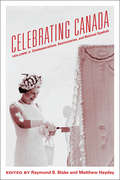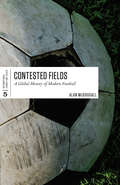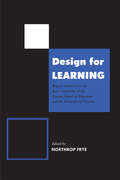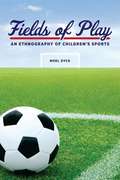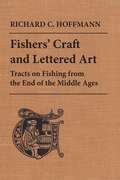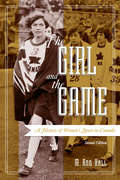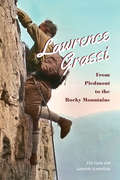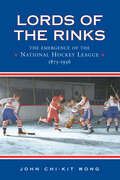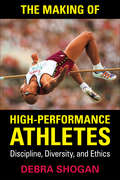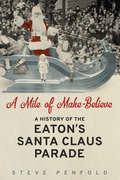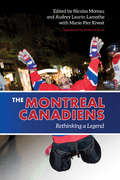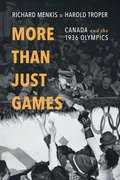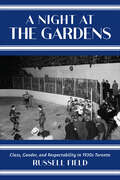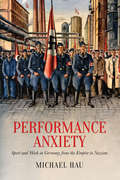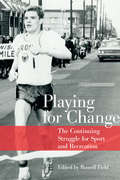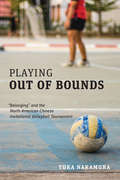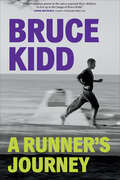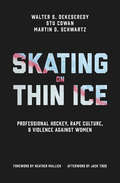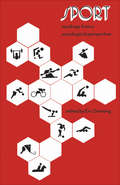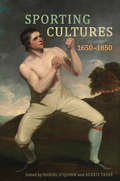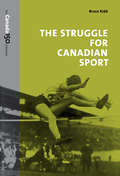- Table View
- List View
Celebrating Canada: Commemorations, Anniversaries and National Symbols
by Raymond B. Blake Mathew HaydayPopular and government-funded anniversaries and commemorations, combined with national symbols, play significant roles in shaping how we view Canada, and also provide opportunities for people to challenge the pre-existing or dominant conceptions of the country. Volume 2 of Celebrating Canada continues the scholarly debate about commemoration and national identity. Raymond B. Blake and Matthew Hayday bring together emerging and established scholars to consider key moments in Canadian history when major anniversaries of Canada’s political, social, or cultural development were celebrated. The contributors to this volume capture the multiple and multi-layered meanings of belonging in the Canadian experience, investigate various attempts at shaping and re-shaping identities, and explore episodes of groups resisting or participating in the identity-formation process. By considering the small voices and those on the margins of Canada’s many commemorative anniversaries, the contributors to Celebrating Canada reveal how important it is to think not only about anniversary moments but also about what they can tell us about our history and the shifting function of nationalism.
Coast to Coast
by John Chi-Kit WongAs an institution that helps bind Canadians to an imagined community, hockey has long been associated with an essential Canadian identity. However, this reductionism ignores the ways Canadians consume hockey differently based on their socio-economic background, gender, ethnicity, and location. Moreover, Canadian culture is not static, and hockey's place in it has evolved and changed.In Coast to Coast, a wide range of contributors examine the historical development of hockey across Canada, in both rural and urban settings, to ask how ideas about hockey have changed. Conceptually broad, the essays explore identity formation by investigating what hockey meant to Canadians from the nineteenth century to the Second World War, as well as the role of government, entrepreneurs, and voluntary associations in supporting and promoting the game. Coast to Coast is an intriguing look at the development of a national sport, a must-read for hockey fans and historians alike.
Contested Fields: A Global History of Modern Football (International Themes and Issues)
by Alan McDougallFew cultural activities speak more powerfully to international histories of the modern world than football. In the late nineteenth century, this cheap and simple sport emerged as a major legacy of Britain’s formal and informal empires and spread quickly across Europe, South America, and Africa. More slowly and hesitantly, it made inroads into the sports cultures of North America and Australasia. Today, football (known to many as soccer) is arguably the world’s most popular pastime, an activity played and watched by millions of people around the globe. It has also become the focus of a rich and diverse body of scholarly research. Contested Fields introduces readers to key aspects of the global game, synthesizing research on football’s transnational role in reflecting and shaping political, socio-economic, and cultural developments over the past 150 years. Each chapter uses case studies and cutting-edge scholarship to analyze an important element of football’s international story: migration, money, competition, gender, race, space, spectatorship, and confrontation.
Design for Learning: Reports Submitted to the Joint Committee of the Toronto Board of Education and the University of Toronto
by Northrop FryeThis important book is the result of a study of school curriculum undertaken by a joint committee of the University of Toronto and the Board of Education for the City of Toronto. Three sub-committees, dealing with English, Social Science, and Physical Science, here present preliminary reports which indicate the need for perpetual study if the school curriculum is to be kept abreast of modern developments in each discipline. Committee members responsible for the reports are themselves elementary, secondary or university teachers of experience. Their recommendations, embracing all grades up to and including Thirteen, are specific, stimulating and controversial. They are unanimous only in their concern that necessary changes be made and that study of the curriculum be continuous and objective. The reports are prefaced by a discerning essay written by Northrop Frye, Principal Frye points out that "the real barriers to break down were those between the three major divisions of education, the primary, secondary and university levels, each of which tends to become a self-enclosed system, congratulating itself on its virtues and blaming whatever deficiencies the educational process as a whole may have on the other systems." This book will be of interest to teachers at all levels, to officials, responsible for policy in our public education, to trustees, to parents, and to the increasing number of general public who care about education. The Chairmen of the three committees were: English, Mary Campbell (Parkdale Collegiate Institute); Social Science, C.B. Macpherson (Department of Political Economy, University of Toronto); Physical Science, Charlotte M. Sullivan (Department of Zoology, University of Toronto). The Editor, Northrop Frye, is Principal of Victoria College, University of Toronto.
Fields of Play: An Ethnography Of Children's Sports (Teaching Culture: Utp Ethnographies For The Classroom Ser.)
by Noel DyckThousands of children participate in community sports every year, enjoying recreation time with their peers, getting healthy exercise, and learning a variety of personal and group skills. At the same time, children's sports are not without controversy: parents can be overly invested in their children's exploits, competitive success is often the focus, and rising costs can limit participation. Consider, too, that these activities, billed as being for the kids, are often overlaid with other agendas by the adults who volunteer, work, and generally support children's sports. Noel Dyck incorporates nearly two decades of ethnographic field research into this anthropologically informed account that illustrates how all those involved in children's sports—boys and girls, parents, coaches, and sport officials—shape these complex, vibrant fields of play. In the process, he explores larger questions and debates about contemporary family and community and the shaping of childhood, youth, and adulthood. Bridging anthropology, sport studies, and childhood studies, Fields of Play offers a rich understanding of an area that has, to date, gained relatively little attention by social scientists.
Fishers' Craft and Lettered Art: Tracts on Fishing from the End of the Middle Ages (The Royal Society of Canada Special Publications #12)
by Richard C. HoffmannFishers' Craft and Lettered Art provides editions, English translations, and analysis from social, cultural, and environmental perspectives of the three oldest European extended tracts on fishing. Richard Hoffmann discusses the history of fishing in popular culture and outlines the economic and ecologic considerations needed to examine and understand the fishing manuals. Hoffmann further explores how continental fishing traditions were conveyed from oral craft practice into printed culture, and proposes that these manuals demonstrate a lively and complex interaction between written texts and popular culture. The tracts are presented in their original languages - Spanish and German - with facing page translations. Close attention is paid to original setting, functions, and possible range of readings, with detailed explanatory notes to help modern fishers and historians.Fishers' Craft and Lettered Art is a fascinating look at one vital aspect of everyday life at the end of the Middle Ages.
The Girl and the Game: A History Of Women?s Sport In Canada, Second Edition
by M. Ann HallIn the second edition of this groundbreaking social history, M. Ann Hall begins with an important new chapter on Aboriginal women and early sport and ends with a new chapter tying today's trends and issues in Canadian women's sport to their origins in the past. Students will appreciate the more descriptive chapter titles and the restructuring of the book into easily digestible sections. Fifty-two images complement Hall's lively narrative.
Lawrence Grassi
by Gabriele Scardellato Elio CostaLawrence Grassi was a trailblazer in every sense of the word. A working-class man of humble Italian origins who worked as a labourer and a coal miner for most of his life, Grassi had a deep passion for the Rocky Mountains. He was famous in the region for his commitment as a guide, a mountain climber, and a builder of greatly admired hiking trails. Today, in or near Canmore, his name graces a mountain, two lakes, and a school, and he is commemorated at Lake O'Hara in Yoho National Park.In Lawrence Grassi: From Piedmont to the Rocky Mountains, Elio Costa and Gabriele Scardellato uncover the deeply private man behind this legend, from his birth in the small Italian village of Falmenta to his long and inspirational career in Canada. Using previously unexamined family letters and extensive information on Grassi's cohort of Italian immigrants, the authors reconstruct his personal and professional life, correcting myths and connecting his story to the long history of Italian immigration to Canada. The definitive biography of this Canadian mountain hero, Lawrence Grassi will be essential reading for those interested in the history of immigration, sport, and the Rocky Mountains.
Lords of the Rinks
by John Chi-Kit WongNo sport is as important to Canadians as hockey. Though there may be a great many things that divide the country, the love of hockey is perhaps its single greatest unifier. Before the latest labour unrest in the National Hockey League (NHL), however, it was easy to forget that hockey is also a multi-million dollar business run, not by the athletes or coaches, but by corporate boards and businessmen. The Lords of the Rinks documents the early years of hockey?s professionalization and commercialization and the emergence of a fledgling NHL, from 1875 to 1936.As the popularity of hockey grew in Canada in the late nineteenth century, so too did its commercial aspects, and players, club directors, rink owners, fans, and media had developed deep emotional, economic, and ideological interests in the sport. Disagreement came in the ways and means of how organized hockey, especially at the elite level, should be managed. Hence, some coordination, by way of governing bodies, was required to maintain a semblance of order. These early administrative bodies tried to maintain a structure that would help to coordinate the various interests, set up standards of behaviour, and impose mechanisms to detect and punish violators of governance. In 1917, the NHL held its first games and by 1936 had become the dominant governing body in professional hockey.Having performed extensive research in the NHL archives ? including league meeting minutes, letters, memos, telegrams, as well as gate receipt reports ? John Chi-Kit Wong traces the commercial roots of hockey and argues that, in its organized form, the sport was rarely if ever without some commercial aspects despite labels such as amateur and professional. The Lords of the Rinks is the only truly comprehensive and scholarly history of the league and the business of hockey. Disclaimer: The image on page 22 has been removed at the request of the rights holder.
The Making of High Performance Athletes
by Debra ShoganHighly skilled athletes are produced by technologies of training which seek to create the athlete as a singular identity. Yet the disciplinary model of modern sport is consistently disrupted by the diversity and hybridity of the participants. Using Foucault's work on disciplinary power as a theoretical framework, Debra Shogan, an academic in sports ethics and a coach of high performance athletes, examines the ways in which athletes are produced through technologies of training and the ethical issues which emerge when demands to improve performance envelopes athletes, coaches, administrators and sports scientists in decisions about how far to push the limits of performance. Making the case for a new, postmodern sports ethic, Shogan shows how the juxtaposition of hybrid athletes with the homogenizing technologies of sport discipline opens up spaces for questioning, refusing, and perhaps creating new ways of participating in sport.
A Mile of Make-Believe: A History of the Eaton's Santa Claus Parade
by Steve PenfoldA Mile of Make Believe examines the unique history of the Santa Claus parade in Canada. This volume focuses on the Eaton's sponsored parades that occurred in Toronto, Montreal and Winnipeg as well as the shorter-lived parades in Calgary and Edmonton. There is also a discussion of small town alternatives, organized by civic groups, service clubs, and chambers of commerce. By focusing on the pioneering effort of the Eaton's department store Steve Penfold argues that the parade ultimately represented a paradoxical form of cultural power: it allowed Eaton's to press its image onto public life while also reflecting the decline of the once powerful retailer. Penfold's analysis reveals the "corporate fantastic" - a visual and narrative mix of meticulous organization and whimsical style- and its influence on parade traditions. Steve Penfold's considerable analytical skills have produced a work that is simultaneously a cultural history, history of business and commentary on consumerism. Professional historians and the general public alike would be remiss if this wasn't on their holiday wish list.
The Montreal Canadiens
by Nicolas Moreau Howard Scott Marie-Pier Rivest Audrey Laurin-LamotheOne of the most famous and certainly most successful professional hockey teams of all time, the Montreal Canadiens are practically a national institution in Quebec society. More than any other team, the Habs play an important role in the identity, economy, and culture of their home town and province.The essays in The Montreal Canadiens: Rethinking a Legend offer a panoramic view of this influence. What were the connections between the Maurice Richard Riot of 1955 and Quebec's Quiet Revolution? Can we say that loyalty to the team constitutes a religion for its fans? How is corporatization affecting how Quebecers connect with their beloved team? Featuring a wide range of writing on Le Grand Club and its social significance, the book offers a fresh and fascinating perspective on one of Canada's greatest sports teams.
More than Just Games
by Richard Menkis Harold TroperHeld in Germany, the 1936 Olympic Games sparked international controversy. Should athletes and nations boycott the games to protest the Nazi regime? More Than Just Games is the history of Canada's involvement in the 1936 Olympics. It is the story of the Canadian Olympic officials and promoters who were convinced that national unity and pride demanded that Canadian athletes compete in the Olympics without regard for politics. It is the story of those Canadian athletes, mostly young and far more focused on sport than politics, who were eager to make family, friends, and country proud of their efforts on Canada's behalf. And, finally, it is the story of those Canadians who led an unsuccessful campaign to boycott the Olympics and deny Nazi Germany the propaganda coup of serving as an Olympic host.Written by two noted historians of Canadian Jewish history, Richard Menkis and Harold Troper, More than Just Games brings to life the collision of politics, patriotism, and the passion of sport on the eve of the Second World War.
A Night at the Gardens: Class, Gender, and Respectability in 1930s Toronto
by Russell FieldWhen Toronto’s Maple Leaf Gardens opened in 1931, manager Conn Smythe envisioned an arena that would project an aura of middle-class respectability. In A Night at the Gardens, Russell Field shares how this new arena anticipated spectators by examining varying spectator behaviours, who the spectators were, and what the experience of spectating was like. Drawing on archival records, the book explores the neighbourhood in which Maple Leaf Gardens was situated, the design of the arena’s interior spaces, and the ways in which the venue was operated in order to appeal to respectable spectators at a particular intersection of class and gender. Oral history interviews with former spectators at Maple Leaf Gardens detail the experience of watching the spectacle that unfolded on the ice during each hockey game. A Night at the Gardens tells the fascinating story of how one prominent public building became such an important part of Toronto society.
Performance Anxiety: Sport and Work in Germany from the Empire to Nazism
by Michael HauPerformance Anxiety analyses the efforts of German elites, from 1890 to 1945, to raise the productivity and psychological performance of workers through the promotion of mass sports. Michael Hau reveals how politicians, sports officials, medical professionals, and business leaders, articulated a vision of a human economy that was coopted in 1933 by Nazi officials in order to promote competition in the workplace. Hau’s original and startling study is the first to establish how Nazi leaders’ discourse about sports and performance was used to support their claims that Germany was on its way to becoming a true meritocracy. Performance Anxiety is essential reading for political, social, and sports historians alike.
Playing for Change
by Russell FieldFor more than forty years, scholars of the history and sociology of sport and recreation have studied how, no matter the time or place, sport is always more than just a game. In Playing for Change, leading scholars in the field of sports studies consider that legacy and forge ahead into the discipline's future. Through essays grouped around the themes of international and North American sport, including the Vancouver and Sochi Olympic Games; access to physical activity in Canadian communities; and the role of activism and the public intellectual in the delivery of sport, the contributors offer a comprehensive examination of the institutional structures of sport, physical activity, and recreation. This book provides wide-ranging examples of cutting-edge research in a vibrant and growing field.
Playing Out of Bounds: “Belonging” and the North American Chinese Invitational Volleyball Tournament (G - Reference, Information and Interdisciplinary Subjects)
by Yuka NakamuraPlaying Out of Bounds investigates the North American Chinese Invitational Volleyball Tournament (NACIVT), an annual event that began in the 1930s in the streets of Manhattan and now attracts 1200 competitors from the U.S. and Canada. Its two key features are the 9-man game, where there are nine instead of the usual six volleyball players on the court, and the fact that player eligibility is limited to "100% Chinese" and Asian players, as defined in the tournament rules. These rules that limit competitors to specific ethno-racial groups is justified by the discrimination that Chinese people faced when they were denied access to physical activity spaces, and instead played in the alleyways and streets of Chinatowns. Drawing on interviews, participant-observation, and analysis of websites and tournament documents, Playing Out of Bounds explores how participants understand and negotiate their sense of belonging within this community of volleyball players and how membership within and the boundaries of this community are continually being (re)defined. This identity/community building occurs within a context of anti-Asian racism, growing numbers of mixed race players, and fluidity of what it means to be Canadian, American, Chinese, and Asian.
A Runner’s Journey
by Bruce KiddIn the 1960s, Bruce Kidd was one of Canada’s most celebrated athletes. As a teenager, Kidd won races all over the globe, participated in the Olympics, and started a revolution in distance running and a revival in Canadian track and field. He quickly became a symbol of Canadian youth and the subject of endless media coverage. Although most athletes of his generation were cautioned to keep their opinions to themselves, Kidd took it upon himself to speak out on the problems and possibilities of Canadian sport. Encouraged by his parents and teammates, Kidd criticized the racism and sexism of amateur sport in Canada, the treatment of players in the National Hockey League, American control of the Canadian Football League, and the uneven coverage of sports by the media – and he continues to fight for equity to this day. After retiring from his career as an athlete, Kidd became a well-known advocate for gender and racial justice and an academic leader at the University of Toronto. Depicting a Canadian sport legend’s journey of joy, discovery, and activism, this memoir bears witness to the remarkable changes Bruce Kidd has lived through in more than seventy years of participation in Canadian and international sports.
Skating on Thin Ice: Professional Hockey, Rape Culture, and Violence against Women
by Walter DeKeseredy Stu Cowan Martin D. SchwartzSkating on Thin Ice exposes the culture of toxic masculinity in professional hockey and suggests how sport and society can change the narrative on sexual assault and violence. Why is it that professional sports, and notably hockey, remain a bastion for rape culture and violence against women? What are the conditions that allow a culture of toxic masculinity to persist despite awakenings elsewhere in society? What is the path forward, and how do we make officials, coaches, and athletes accountable? Drawing on decades of award-winning sociological research and sports journalism, Walter S. DeKeseredy, Martin D. Schwartz, and veteran sportswriter Stu Cowan find answers to these questions in Skating on Thin Ice. The book examines the abusive, misogynistic, racist, and homophobic behaviors found in professional hockey and explains the larger societal forces that perpetuate and legitimate these harms. Confirming a recent federal government inquiry into Hockey Canada’s handling of sexual assault allegations, the book reveals that young men enter the NHL and other revenue-generating hockey leagues already trained and primed to treat women as objects – and often to commit violent acts against them. Rooted in the authors’ work in the sports world as well as their work with activists and governments, Skating on Thin Ice doesn’t just highlight the problem of hockey and rape culture, it also provides collaborative solutions for fixing it.
Spirits of the Rockies
by Courtney W. MasonThe Banff-Bow Valley in western Alberta is the heart of spiritual and economic life for the Nakoda peoples. While they were displaced from the region by the reserve system and the creation of Canada's first national park, in the twentieth century the Nakoda reasserted their presence in the valley through involvement in regional tourism economies and the Banff Indian Days sporting festivals.Drawing on extensive oral testimony from the Nakoda, supplemented by detailed analysis of archival and visual records, Spirits of the Rockies is a sophisticated account of the situation that these Indigenous communities encountered when they were denied access to the Banff National Park. Courtney W. Mason examines the power relations and racial discourses that dominated the eastern slopes of the Canadian Rocky Mountains and shows how the Nakoda strategically used the Banff Indian Days festivals to gain access to sacred lands and respond to colonial policies designed to repress their cultures.
Sport: Readings from a Sociological Perspective
by Eric DunningSport is something rather taken for granted and little studied as part of man's and society's behaviour. This collection of essays, many of which appear in print for the first time, provides an international comparative and developmental orientation to the sociology of sport, thereby clarifying the nature of modern sports and their central structural and functional characteristics. The sports treated include football, soccer, rugby, wrestling, baseball, and bull-fighting, and some historical background is given on the development of sport. In the introduction to each section, the editor explains the questions that the selections are intended to illustrate, and treats briefly such matters as theories of sport and play, the social factors in their development, sport and socialization, class and race in sport, sport as an occupation and an industry, and conflict and social control in sport. This reader will be of interest to those professionally concerned, either as teacher or student, with sociology and physical education, but it should also appeal to athletes, sports-lovers, and sports commentators who like to keep their thinking in good shape too.
Sporting Cultures, 1650–1850
by Daniel O'Quinn Alexis TadieIn the eighteenth century sport as we know it emerged as a definable social activity. Hunting and other country sports became the source of significant innovations in visual art; racing and boxing generated important subcultures; and sport’s impact on good health permeated medical, historical, and philosophical writings. Sporting Cultures, 1650–1850 is a collection of essays that charts important developments in the study of sport in the eighteenth century. Editors Daniel O’Quinn and Alexis Tadié have gathered together an array of European and North American scholars to critically examine the educational, political, and medical contexts that separated sports from other physical activities. The volume reveals how the mediation of sporting activities, through match reports, pictures, and players, transcended the field of aristocratic patronage and gave rise to the social and economic forces we now associate with sports. In Sporting Cultures, 1650–1850 , O’Quinn and Tadié successfully lay the groundwork for future research on the complex intersection of power, pleasure, and representation in sports culture.
Stickhandling through the Margins
by Michael A. RobidouxSome of hockey's fiercest and most passionate players and fans can be found among Canada's First Nations populations, including NHL greats Jordin Tootoo, Jonathan Cheechoo, and Gino Odjick. At first glance the importance of hockey to the country's Aboriginal peoples may seem to indicate assimilation into mainstream society, but Michael A. Robidoux reveals that the game is played and understood very differently in this cultural context. Rather than capitulating to the Euro-Canadian construct of sport, First Nations hockey has become an important site for expressing rich local knowledge and culture.With stories and observations gleaned from three years of ethnographic research, Stickhandling through the Margins richly illustrates how hockey is played and experienced by First Nations peoples across Canada, both in isolated reserve communities and at tournaments that bring together participants from across the country. Robidoux's vivid description transports readers into the world of First Nations hockey, revealing it to be a highly social and at times even spiritual activity ripe with hidden layers of meaning that are often surprising to the outside observer.
The Struggle for Canadian Sport
by Bruce KiddCanadian sports were turned on their head during the years between the world wars. The middle-class amateur men's organizations which dominated Canadian sports since the mid-nineteenth century steadily lost ground, swamped by the rise of consumer culture and badly battered and split by the depression. In The Struggle for Canadian Sport Bruce Kidd illuminates the complex and fractious process that produced the familiar contours of Canadian sport today -- the hegemony of continental cartels like the NHL, the enormous ideological power of the media, the shadowed participation of women in sports, and the strong nationalism of the amateur Olympic sports bodies.Kidd focuses on four major Canadian organizations of the interwar period: the Amateur Athletic Union, the Women's Amateur Athletic Federation, the Workers' Sport Association, and the National Hockey League. Each of these organizations became focal points of debate and political activity, and they often struggled with each other - each had a radically different agenda: The AAU sought `the making of men' and the strengthening of English-Canadian nationalism; the WAAF promoted the health and well-being of sportswomen; the WSA was a vehicle for socialism; and the NHL was concerned with lucrative spectacles. These national organizations stimulated and steered many of the resources available for sport and contributed significantly to the expansion of opportunities. They enjoyed far more power than other Canadian cultural organizations of the period, and they attempted to manipulate both the direction and philosophy of Canadian athletics. Through their control of the rules and prestigious events and their countless interventions in the mass media, they shaped the dominant practices and coined the very language with which Canadians discussed what sports should mean. The success and outcome of each group, as well as their confrontations with one another were crucial in shaping modern Canadian sports. The Struggle for Canadian Sport adds to our understanding of the material and social conditions under which people created and elaborated sports and the contested ideological terrain on which sports were played and interpreted.Winner of the North American Society for Sports History (NASSH) 1997 book award
The Struggle for Canadian Sport
by Bruce KiddCanadian sports were turned on their head during the years between the world wars. The middle-class amateur men's organizations which dominated Canadian sports since the mid-nineteenth century steadily lost ground, swamped by the rise of consumer culture and badly battered and split by the depression. In The Struggle for Canadian Sport Bruce Kidd illuminates the complex and fractious process that produced the familiar contours of Canadian sport today -- the hegemony of continental cartels like the NHL, the enormous ideological power of the media, the shadowed participation of women in sports, and the strong nationalism of the amateur Olympic sports bodies.Kidd focuses on four major Canadian organizations of the interwar period: the Amateur Athletic Union, the Women's Amateur Athletic Federation, the Workers' Sport Association, and the National Hockey League. Each of these organizations became focal points of debate and political activity, and they often struggled with each other - each had a radically different agenda: The AAU sought `the making of men' and the strengthening of English-Canadian nationalism; the WAAF promoted the health and well-being of sportswomen; the WSA was a vehicle for socialism; and the NHL was concerned with lucrative spectacles. These national organizations stimulated and steered many of the resources available for sport and contributed significantly to the expansion of opportunities. They enjoyed far more power than other Canadian cultural organizations of the period, and they attempted to manipulate both the direction and philosophy of Canadian athletics. Through their control of the rules and prestigious events and their countless interventions in the mass media, they shaped the dominant practices and coined the very language with which Canadians discussed what sports should mean. The success and outcome of each group, as well as their confrontations with one another were crucial in shaping modern Canadian sports. The Struggle for Canadian Sport adds to our understanding of the material and social conditions under which people created and elaborated sports and the contested ideological terrain on which sports were played and interpreted.Winner of the North American Society for Sports History (NASSH) 1997 book award
